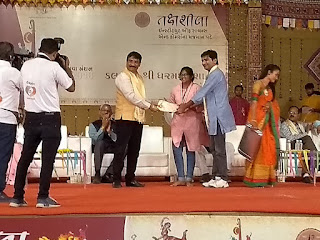Our University has organised "Aishvaryam Youth Festival 2018" for 3 days from 26/10/2018 to 28/10/2018. Many events were organised in the youth festival. They are:
Kalayatra, Quiz, poetry recitation, on the spot painting, mimicry, bhajan, cartooning, paper collage, mono acting, sugam geet, folk dance, solo folk dance, western dance, western solo dance, folk orchestra, essay writing, elocution, rangoli...etc,.
I could not attend all events. Because I was presented at our department as a volunteer. Quiz and Essay writing competitions were organised at our department. On 26 October, the first round of Quiz was stared. On 27 October, the final round of quiz and essay writing were organised. The time of final round of quiz was at 9:00 a.m. , but it was postponed due to some problem of electricity. So the final round was began at 11:00 a.m..
On 27th October, I attended 2-3 events. First I attended the western group song. I enjoyed it. I also feel proud on the group of our department who got the second rank in the youth festival. I also observed that the group of our department has dress code of 'Tri-Ranga'. Orange, white, blue, white, green. I like their dress code.
Then I attended the event of solo western song. I listened 3-4 songs. I liked only 2 songs. I eagerly waited for Vidhya's performance. When she came on the stage, we all cheer up her. Then she started to sing a song and the audience mingled with her tuning. The audience really enjoyed her song. And finally Vidhya got the second rank in the youth festival.
Then I attended the event of Drama at Atal Auditorium. When we reached at Auditorium, we found that the Auditorium was packed with the audience. But thanks to Bhavnesh one of my classmate, who arranged seats for us. We could not enjoy the drama because some boys spread nuisance. Our university arranged the committee for controlling the audience. Though, some boys did not listen to the member of committee.
I saw the drama 'Third side of Coin'. In this drama, the story of a child who was not a man and a woman. But the child was the 'Hijada'. They were not accepted by the society and also their family. In this drama we can see the struggle of third gender child and the mother of this child. This drama gave the moral.
Then I saw the another drama 'Aurangzeb'. This drama was heart touching. All the characters performed confidently. Then I also liked the drama 'sagar Khedu sarvan', which got the second rank in the youth festival.
From our department, Bhavnesh participated in elocution, Prakruti participated in quiz, Laljibhai participated in poster making, Dipti participated in sugam geet and western group song, Vidhya also participated in western group and solo song, Rajdeep participated in mimicry, Nirali performed mono acting, Dharma performed mime, and other students performed drama, Zankhna draw the rangoli on the current situation. And she got the third rank in the youth festival.
Really, I enjoyed the 'Aishvariyam Youth Festival'. I inspired from all the participated and I thought that I will participate in youth festival next year. I am eagerly waiting for the next year's Youth Festival. This year S. S. C. C. M became champion and the K. P. E. S became the first runners and Taksheela became second runners.

























Fantastic
ReplyDeleteThnxx Prashant bhai
ReplyDeleteWelcome Krishna
ReplyDeleteWell written dear
ReplyDeleteThnxx Hina
ReplyDelete